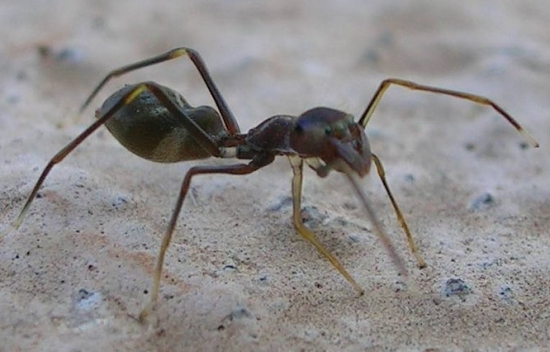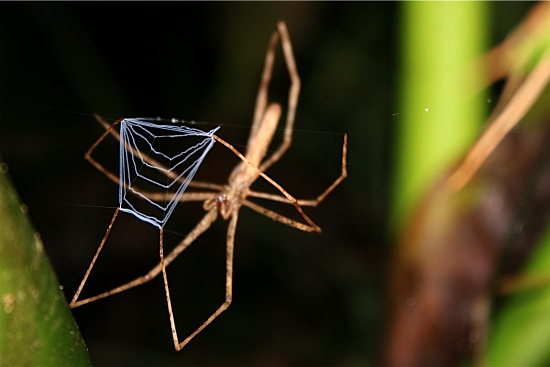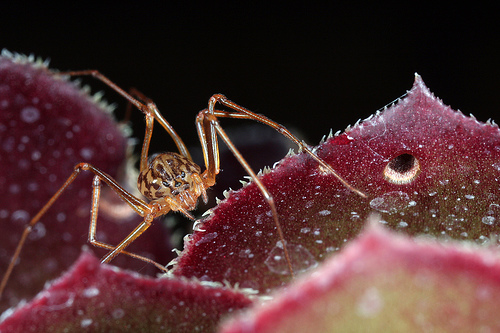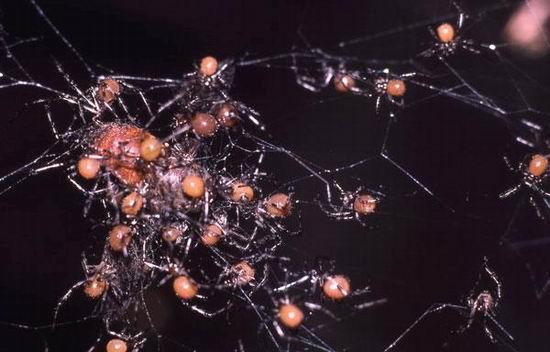| The Ten Coolest Spiders - part one! |
| #8 - Net-throwing "ogres" |
Neither an active hunter nor content to let its web do all the work, the "net casting" or
"ogre faced" spider hangs just above the ground and grasps a small "capture net" in
its four front legs, lashing out to scoop up passing insects for consumption. Strangely,
this net is not sticky like most spider's silk, but uses its tangled, woolly texture to trap
insects like a sort of "velcro."
In case you were wondering, here's that "ogre face" they were named for.
"ogre faced" spider hangs just above the ground and grasps a small "capture net" in
its four front legs, lashing out to scoop up passing insects for consumption. Strangely,
this net is not sticky like most spider's silk, but uses its tangled, woolly texture to trap
insects like a sort of "velcro."
In case you were wondering, here's that "ogre face" they were named for.
| #10 - The Lurker Below |
Well known to tarantula hobbyists, the various species of "trapdoor" spider hunt by
digging a deep burrow topped with a well-camouflaged lid of silk, soil and detritus.
When the vibration of an insect or other small animal is detected within reach, the
powerful and aggressive spider springs from its home at lightning speed to drag the
prey underground.
digging a deep burrow topped with a well-camouflaged lid of silk, soil and detritus.
When the vibration of an insect or other small animal is detected within reach, the
powerful and aggressive spider springs from its home at lightning speed to drag the
prey underground.
| #9 - The Ant-Mimics |
What you are looking at in this photograph is not an ant or even an insect, but a highly
specialized arachnid demonstrating species mimicry. Its abdomen and cephalothorax
- the two sections of a spider's body - adopt a stretched and pinched shape to
resemble the head, thorax and abdomen of an ant, while its foremost pair of legs are
held out like a set of antennae. Various spiders - as well as other groups of arthropoda
- may demonstrate ant mimicry for a variety of reasons, not all of them easy to
distinguish. Some are major predators of the insects they resemble, and may even
sneak into the colony itself. Others exhibit no such dietary preference, and may employ
the charade more to hide from other predators than as a hunting strategy.
specialized arachnid demonstrating species mimicry. Its abdomen and cephalothorax
- the two sections of a spider's body - adopt a stretched and pinched shape to
resemble the head, thorax and abdomen of an ant, while its foremost pair of legs are
held out like a set of antennae. Various spiders - as well as other groups of arthropoda
- may demonstrate ant mimicry for a variety of reasons, not all of them easy to
distinguish. Some are major predators of the insects they resemble, and may even
sneak into the colony itself. Others exhibit no such dietary preference, and may employ
the charade more to hide from other predators than as a hunting strategy.
| #7 - The Original "Web Slinger" |
In cartoons and video games, spiders are often portrayed spraying silk from their
mouths in pursuit of prey. In the real world, only a single small family, the Scytodidae, is
armed with such a mechanism. The remarkable venom glands of these spiders extend
all the way through the body to connect with the silk glands, allowing the spider to squirt
twin streams of fast-drying, poisoned glue at distant insects. As it spits, it rocks back
and forth, laying down its sticky trap in a zig-zag pattern.
mouths in pursuit of prey. In the real world, only a single small family, the Scytodidae, is
armed with such a mechanism. The remarkable venom glands of these spiders extend
all the way through the body to connect with the silk glands, allowing the spider to squirt
twin streams of fast-drying, poisoned glue at distant insects. As it spits, it rocks back
and forth, laying down its sticky trap in a zig-zag pattern.
| #6 - The Legion |
Most spiders are not only solitary, but aggressively antisocial, indiscriminately
attacking and preying upon any other spider to cross their path at the wrong time. A
rare handful, however, have demonstrated varying degrees of communal behavior, and
perhaps none are so social as Theridion nigroannulatum, a species discovered only
recently in the forests of Ecuador. These tiny spiders form colonies of up to several
thousand individuals, which cling to the undersides of large leaves and dangle threads
of silk to the forest floor. When an insect stumbles into these nearly invisible trip wires,
dozens of spiders may descend at once to encase the prey in silk, incapacitate it with
venom and haul it back up to be shared among the colony.
attacking and preying upon any other spider to cross their path at the wrong time. A
rare handful, however, have demonstrated varying degrees of communal behavior, and
perhaps none are so social as Theridion nigroannulatum, a species discovered only
recently in the forests of Ecuador. These tiny spiders form colonies of up to several
thousand individuals, which cling to the undersides of large leaves and dangle threads
of silk to the forest floor. When an insect stumbles into these nearly invisible trip wires,
dozens of spiders may descend at once to encase the prey in silk, incapacitate it with
venom and haul it back up to be shared among the colony.
With at least 40,000 described species, spiders comprise the largest order within the
class Arachnida, sharing it with others such as the mites, scorpions, harvestmen and
many more. Though the vast majority are utterly harmless to humans, they have
inspired the single most common phobia known to modern psychology, more widely
feared than the deadliest sharks, mammals and reptiles combined. In Japanese
mythology, spiders fill the same role as western dragons; huge and terrifying monsters
with mysterious powers and ravenous appetites, hunted and slain by only the bravest
warriors. If these legendary giants took after some of the following, however, such tales
might have ended rather prematurely...Enjoy a two-page countdown of what I consider
the ten most fascinating Aranea you may ever learn about!
class Arachnida, sharing it with others such as the mites, scorpions, harvestmen and
many more. Though the vast majority are utterly harmless to humans, they have
inspired the single most common phobia known to modern psychology, more widely
feared than the deadliest sharks, mammals and reptiles combined. In Japanese
mythology, spiders fill the same role as western dragons; huge and terrifying monsters
with mysterious powers and ravenous appetites, hunted and slain by only the bravest
warriors. If these legendary giants took after some of the following, however, such tales
might have ended rather prematurely...Enjoy a two-page countdown of what I consider
the ten most fascinating Aranea you may ever learn about!




| Written by Jonathan C. Wojcik - Photo credits unknown or from public news outlets. |